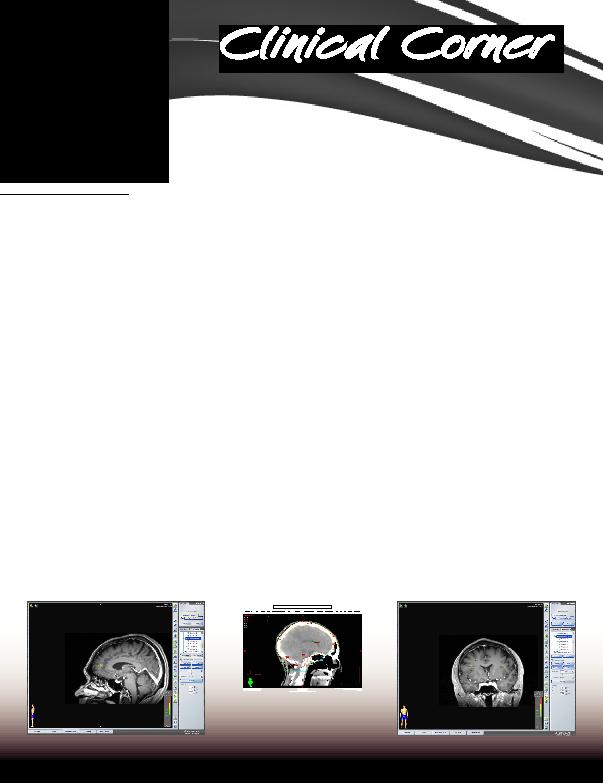
Being diagnosed with cancer can be a very
overwhelming experience, but being told you have
brain cancer can add even more fear and anxiety. Our
brain helps us to function daily, whether we use it for
recalling old memories, telling our mouths what to
say, or just daily problem solving, we would be lost
without the use of it, literally. So, when we are told
we have a tumor in the brain, we want to know the
best way to treat the tumor and keep the quality of life
we have become accustomed to.
Tumors that start in the brain are called primary brain
tumors. These tumors can be malignant (cancerous)
or they can be benign (non cancerous). Tumors that
start somewhere else, such as the lung or breast, and
then spread to the brain are called metastatic brain
tumors. These tumors are always cancerous.
The type of treatment that is best for you depends
on the type, size and location of the tumor and your
overall health and preferences. There are four standard
types of treatment options available; watchful waiting,
surgery, chemotherapy, and radiation. Watchful
waiting is just that, closely monitoring your condition
until symptoms appear or change. Surgery is the
surgical removal of all or most of the tumor. Surgery
can be followed by chemotherapy and/or radiation
to kill any cancer cells that remain. Chemotherapy
uses drugs to stop the growth of the cancer cells,
either by killing them or stopping them from dividing.
Radiation uses high energy x-rays to kill the cancer
cells or keep them from dividing.
At the Tri-Cities Cancer Center we employ the
treatment option of radiation to treat cancer. However,
occasionally a person will require a combination of
treatment types (not just radiation) to treat their
cancer, so we work very closely with the surgeons and
the chemotherapy doctors to make sure everything
is coordinated. By using radiation, we are able to
focus precisely on the tumor and minimize radiation
to healthy and normal brain tissue. There are several
different techniques we can use here at the Tri-Cities
Cancer Center to focus the radiation:
Two-Dimensional Radiation Therapy (2D-RT):
2D-RT uses, usually, two radiation beams to treat the
whole brain. This is most commonly used to treat the
brain when there are many metastatic tumors that
have spread from another location.
Three-Dimensional Conformal Radiation
Therapy (3D-CRT):
3D-CRT uses multiple
radiation beams coming in from different directions
to conform the dose around the tumor. This also helps
Shelley Cole, CMD
Medical Dosimetrist
Brain Cancer Treatment Options
Clinical Corner
Patient:
Course:
Plan:
GOTTWIG, MARY (T1200159)
C1 BRAIN/L KNEE
BRAIN - Planning Approved
X: 0.63 cm
Scaling Factor: 75%
Head First-Supine
User origin DICOM offset = (-0.21cm, -3.16cm, 0.00cm)
External Beam Planning External Beam Planning 8.6.17
Printed 5/8/2013 11:54 AM by ShelleyC
Page 1/1
Patient Name:
Hospital:
Plan last modified:
GOTTWIG, MARY (T1200159)
TCCC, Kennewick, WA, USA
5/11/2012 11:08 AM by kristi
Course:
Plan:
Image:
C1 BRAIN/L KNEE
BRAIN, BRAIN
BRAIN
Plan normalization value:
Calculation grid:
Maximum dose:
99.0 %
2.5 mm
114.2 %
WARNING: Hidden field and field accessory outlines not included in the printout!
Fields in plan 'BRAIN' of course 'C1 BRAIN/L KNEE'
Field ID
Technique
Machine
Energy
Scale
Wedge ID
Weight
X1[cm] X2[cm]
Y1[cm] Y2[cm]
Gantry Rtn[deg]
Coll Rtn[deg]
Couch Rtn[deg]
X[cm]
Y[cm]
Z[cm]
SSD[cm]
MU
03
STATIC-I
21EX
6X
VAR
0.550
+13.0 +10.0
+9.5 +8.0
270.0
180.0
180.0
0.0
0.0
0.0
94.5
174
04
STATIC-I
21EX
6X
VAR
0.450
+10.0 +13.0
+9.5 +8.0
90.0
180.0
180.0
0.0
0.0
0.0
91.1
159
SRS Sagital
SRS Coronal
2D-RT
Radiation Treatment Techniques

